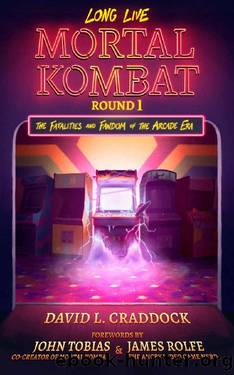Long Live Mortal Kombat: Round 1: The Fatalities and Fandom of the Arcade Era by David L. Craddock

Author:David L. Craddock [Craddock, David L.]
Language: eng
Format: epub
Publisher: Digital Monument Press, LLC
Published: 2022-10-08T06:00:00+00:00
Part 3
Knowledge and Power
Chapter 28
Business As Usual
Mortal Kombat II âs development had been a slow ramp-up. Ed Boon and John Tobias took their time at the beginning, considering the sequelâs direction. However, there comes a point in every development schedule when creative decisions and technological realities reached an impasse. A technique or art direction they believe should work never gets off the ground and they have to rewrite, reanimate, redo. Then thereâs the desire shared by all designers to make the coolest game possible. Passion collides with reality, giving way to weeks or months of 14- and 16-hour days. Some days they work around the clock, sweating every detail.
Their reward for making a successful game is to do it all over again.
Tobias usually finished his work first. Thatâs typical in game development: Artists and writers complete their assetsâscripts, animations, backgroundsâfirst, but programmers work right until release and often beyond. Completing his tasks did not earn Tobias a reprieve. Once MKIIâs art was locked in, he wore other hats, the same as he had done on Smash TV and Total Carnage: testing the game and giving feedback, driving to test locations to pick up quarters and fix glitched machinesâgoing as far as dismantling a cabinet and cleaning joysticks and contact points such as where buttons meet the switches theyâre connected toâanything the team needed to continue their march toward release.
After completing Mortal Kombat IIâs 3.1 revision, the team declared it finished. No more changes to artwork, no more tweaking code to fix bugs or glitches. They had earned a break.
Rest periods were a rarity in the coin-op business. Developers finished one game and, in the same breath, moved on to the next. Mortal Kombat was slightly different. There was more merchandise connected to the franchise than was customary for Midwayâs games. Tobias spent his brief respite working on another collectorâs edition comic book advertised in MKIIâs attract mode and reveled in the process. He still loved comic books; writing a story in the Mortal Kombat universe gave him a break from pushing pixels.
The teamâs creative reprieve was over almost as soon as it began. Midwayâs developers had a blue-collar Chicago work ethic: finish a project, take a breath, then get back to work.
By November 1994, Ken Fedesna was overseeing several games. Two of those were Mortal Kombat II and Killer Instinct. After acquiring Tradewest that April, Midway re-christened the studio as Williams Entertainment, Inc. The plan was for Williams Entertainment to market and convert home versions of Mortal Kombat 3 in parallel to Boon, Tobias, and their team developing the coin-op. âOur deal with Acclaim had expired,â says Fedesna. âMortal Kombat 3ââstylized as MK3 on the arcade marquee, packaging, and in most marketing materialsââwas going to be a big thing for Williams Entertainment.â
Midway planned to take the company public in 1996. Their agenda for the final months of 1994 and the entirety of 1995 was to make the company as strong as possible. âThere was huge pressure to make sure we
Download
This site does not store any files on its server. We only index and link to content provided by other sites. Please contact the content providers to delete copyright contents if any and email us, we'll remove relevant links or contents immediately.
Dawn of the New Everything by Jaron Lanier(2459)
The Infinite Retina by Robert Scoble Irena Cronin(2436)
The Art of Doom by Bethesda(1793)
Significant Zero by Walt Williams(1644)
Creative Character Design by Bryan Tillman(1581)
The Ultimate Roblox Book by David Jagneaux(1435)
World of Warcraft Chronicle Volume 3 by Blizzard Entertainment(1387)
Art Of Atari by Tim Lapetino(1342)
Dawn of the New Everything: Encounters with Reality and Virtual Reality by Jaron Lanier(1342)
Pillars of Eternity Guidebook by Obsidian Entertainment(1286)
1628927445Game by Unknown(1264)
Unreal Engine 4 Virtual Reality Projects by Kevin Mack(1230)
Learning D by 2015(1215)
Unity 2018 By Example by Alan Thorn(1213)
Unreal Engine Virtual Reality Quick Start Guide by Jessica Plowman(1206)
The Ultimate Player's Guide to Minecraft by Stephen O'Brien(1192)
Godot 4 Game Development Cookbook by Jeff Johnson(1192)
Flynn's Log 1 by Stone Marshall(1165)
Road Games by Road Games(1141)
